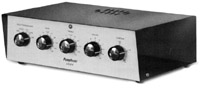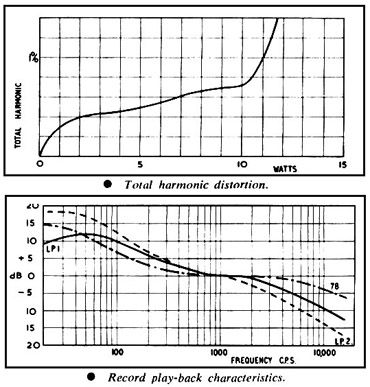
 Taken
from Hi-Fi News, April 1958 Taken
from Hi-Fi News, April 1958
HIGH Fidelity amplifier design seems to be dividing
into two well-defined groups. First, the separate preamplifier or control
unit with a power amplifier intended for hiding away and then table top
models complete and ready for use.
General Description
The Pamphonic 1004 falls into the latter category. Glossy
black knobs adorn a handsome metal cabinet which can safely be stood anywhere
on its protective rubber feet.
The output stage of this amplifier uses two 6BW6s in
ultra-linear push-pull. These valves are the equivalent of the well-known
6V6, but on a Noval base. A 12AX7 double triode is used in the phase splitter.
The output transformer has a tapped secondary so that the negative feedback
which is taken from the whole winding need not be changed when adjusting
for another speaker impedance—moving a small plug at the back of
the amplifier to 3.5 or 15 ohms being all that is required. The feedback
which is taken to the cathode of the first triode in the phase splitter
measured 21 dB at 1 Kc/s.
Preceding this is the built-in preamplifier, which uses
an EF86 at the front end, followed by another 12AX7. The power supply
has a contact cooled rectifier, a component which did, in fact, keep remarkably
cool. In addition to the usual selector switch and tone controls a knob
marked "Contour" is provided, which also operates the on-off
switch.
The back of the amplifier is liberally provided with
plugs, sockets, and various adjustments. These include mains voltage selection
from l00v to 250 v A.C, a special plug to adapt the
PU input to suit a particular cartridge, auxiliary power and tape recorder
outlets, and on the side of the chassis a hum-dinger pot.
Electrical Performance
Power Output

Frequency Response
Measured at the radio position with the tone controls flat this was 2dB
down at 30 c/s and 30 Kc/s.
Tone Controls
The effect of these, as can be seen on the graph, was an engineer's delight,
cut and lift being exactly equal and the flat position being just where
it said on the dial.
Record Equalising
Three curves are provided, those selected being up to date and sufficiently
accurate.

Stability
The amplifier would stand a 12 dB increase in feedback and was stable
on open circuit. Square wave response, however, was not particularly good,
showing some ringing, and capacitive loads of about 0.5.µF produced
instability.

Background
With short-circuited input, figures between 52 dB and 62 dB below 10 watts
were obtained. In this connection no noticeable improvement could be detected
when the hum-dinger was moved from the mid position, which would correspond
to the conventional centre tap.
Contour Control
The effect of this on the frequency response is shown in the graph. The
control is marked on the front at points labelled 0, -l0dB, -20dB and
-30dB. A reasonable method of operation would be to set it at 0, turn
the gain control up until the sound was very loud and then use the contour
control to reduce everything to a more acceptable level. The leaflet provided
suggests that the resulting sound will have the same apparent frequency
response at all levels The reason why this does not seem to be the case
in practice can be seen by comparing the measured curves with those based
on Fletcher-Munson's well-known curves for equal loudness. These were
obtained by plotting the difference between the 50 dB, 60 dB and 70 dB
curves and that for a maximum reasonable loudness of about 80 dB. Large
quantities of treble boost do not seem to be justified.

Comment
The Pamphonic 1004 gives a good impression from the moment it is removed
from its substantial packing, since a proper descriptive booklet complete
with circuit diagram and even spare fuses are provided. This impression
is borne out by the electrical performance, which follows the specification
with great accuracy, and by the listening quality which is of the highest
standard. The general construction is also excellent, a combination of
conventional and printed wiring being used. The variety of co-axial connector
employed, however, is more likely to be popular for its cheapness than
its ease of unplugging. Apart from the contour control the only other
piece of minor criticism concerns the overload capacity of the radio input.
Most tuners are going to need some attenuating to ensure that the signal
level never exceeds 650 mV. These details, though, comprise nearly all
the fault which could be found in a piece of equipment that is definitely
first class audio engineering and excellent value for money.
J.C.L.
Before publication this review was submitted to the
manufacturers, who returned it without comment - Editor.
|

